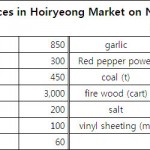Lankov writes in the Korea Times:
One of the most important peculiarities of North Korean life is the degree of isolation of North Koreans from entire world. The government does not want them to be aware of some facts which contradict the officially approved picture of the world and their own country. To make sure that propaganda has no competition, the North Korean authorities eliminate all possible sources of alternative information.
Few if any Communist countries were as efficient as North Korea in cutting their population off from the unwanted and unauthorized knowledge about the world beyond the nation’s boundaries.
Few North Koreans are ever allowed to leave their country. The only statistically large but non-privileged group of people with overseas experience was the Siberian loggers who were sent to the wilderness of Southern Siberia from the late 1960s onwards. However, that part of the world is not famous for a high density population, so their contact with the locals was kept at a bare minimum (and North Korean authorities saw to this).
All other groups of North Koreans who were allowed to travel overseas formed the upper crust of society and by definition were carefully chosen for their supposed political reliability. These privileged few were diplomats, crews of the North Korean ships and planes as well as a handful of the people who were allowed to participate in international exchanges, largely of academic nature. These people had a lot to lose, and they also knew that their families would pay a high price for any wrongdoing they committed, thus they seldom caused trouble. They are least likely to talk much about overseas life.
There were students, of course, but their numbers were very small ― perhaps, less than 10,000 North Koreans ever graduated from foreign universities (just for comparison: some 240,000 South Koreans are studying overseas right now).
The North Koreans cannot buy or read books published overseas ― no exception is made even for books from other Communist countries. All non-technical foreign publications are kept in special departments of libraries and one needs a security clearance to access them. In these departments the subversive material could be read only by the trustworthy people who obtained special permission from security police.
Of course, radio was the major source of worries for the Pyongyang leaders. So, North Korea is the only country which outlaws the use of the radio sets with free tuning. All radio sets are permanently fixed on the wavelength of the official Pyongyang broadcast, and police conduct random house checks to ensure that technically savvy owners have not re-modeled their sets.
In a clearly Orwellian twist, the government does its best to keep the populace cut off from the past as well. All periodicals and most books more than ten years old are to be sent to the same special departments with access being limited to the people with proper security clearance. Even speeches of the Great Leader are edited (rewritten) from time to time to meet the demands of the ever changing political situation.
Why did they do it? The answer seems to be obvious: the governments know that they have to hide the huge difference in economic performance between North Korean and its neighbors, and above all ― between North and South Korea. Currently, the ratio of per capita income between two Korean states is estimated to be at 1:15 at best and 1:50 at worst. This is the largest gap which exists worldwide between two countries which share a land border, and this gap is powerful proof of North Korea’s economic inefficiency. The government understands that once the populace learns about the gap, the situation might get out of control. To prevent it, they work hard to keep people ignorant about the outside world.
Until 2000 or so, they have been generally successful, even though some snippets of dangerous information found their way to North Korea. Things began to change in the late 1990s when North Koreans began to move across the porous border with China. Most of the refugees did not stay in China, but eventually returned to North Korea. They brought back stories of Chinese prosperity, DVDs with South Korean TV shows and small, easy-to-hide transistor radios with free tuning.
Since then, things began to change, and the information self-isolation system began to fall apart. However, it might be premature to believe that it has been damaged beyond repair. Yes, people in the borderland area are aware that they live in a poor and underdeveloped society. Many people in Pyongyang also came to realize this. But it seems that in more remote parts of the country the isolation still works reasonably well.
Sometimes I wonder how shocked North Koreans will be when exposed to the outside world for the very first time. We can be sure that their surprise will be huge ― and perhaps, their disappointment about their country’s past will be huge, too.
Read the full story here:
Crack in Orwellian paradise
Korea Times
Andrei Lankov
11/21/2010

